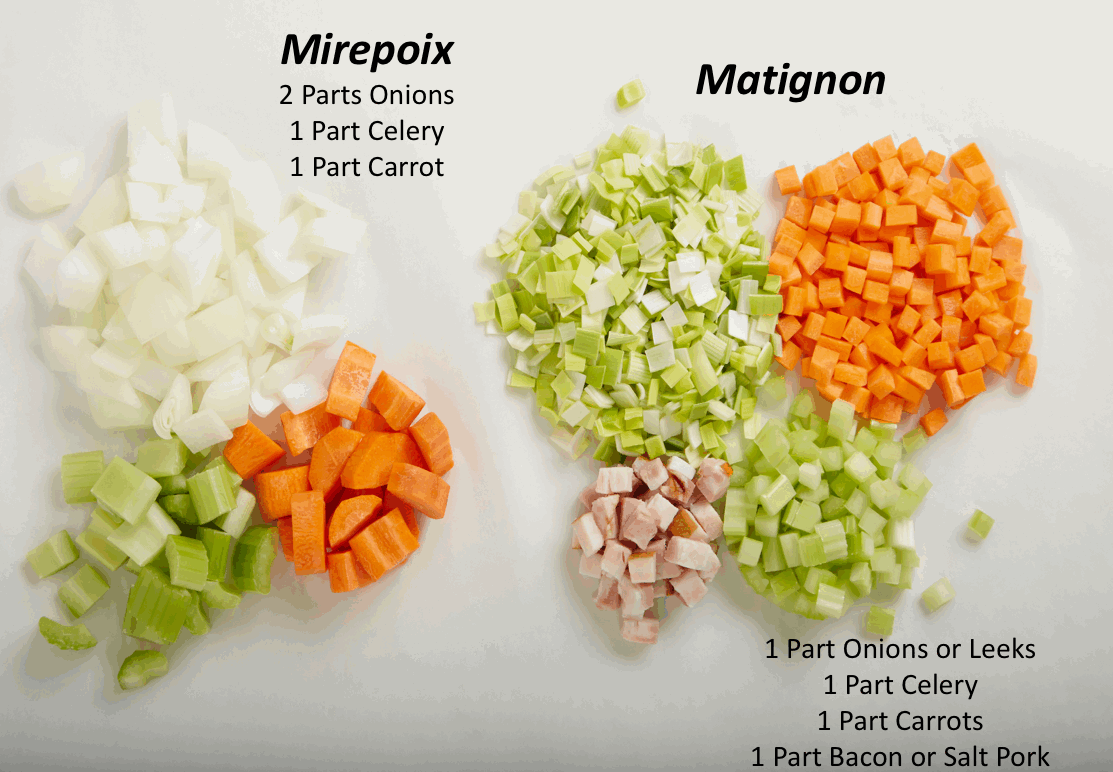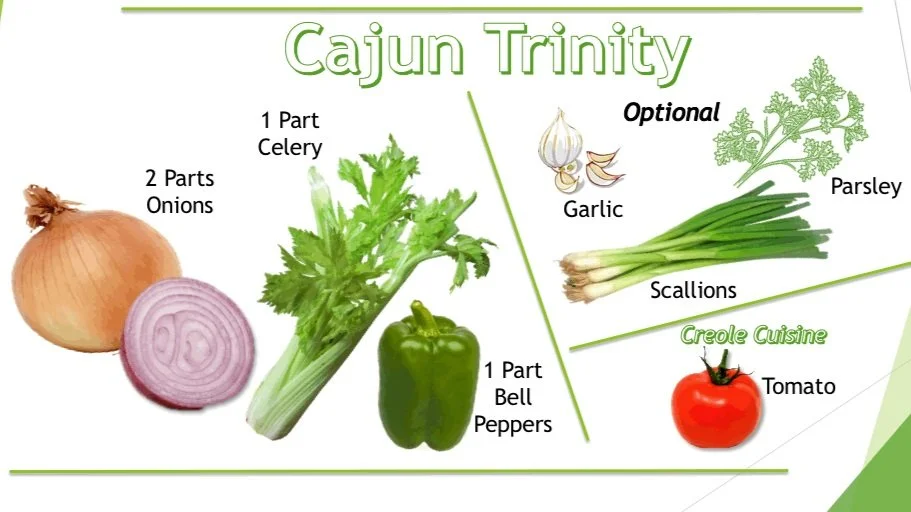How Aromatic Ingredients Enhance Your Cooking
In cooking, certain ingredients enhance the flavor of prepared foods. We call these ingredients aromatics, and they include vegetable, spice, and herb combinations that are the foundation for different ethnic cuisines. These flavor-building ingredients are used in all kinds of dishes, from soups and sauces to stews and stir-fries around the globe. Some, like onions and garlic, are used across most cuisines, while others, like lemongrass and galangal, are specific to geographic regions. So, let’s delve into aromatics and how to use them to create authentically flavored ethnic foods.
French Mirepoix
Many chefs schooled in French cuisine use mirepoix as a foundation in their kitchens. A mirepoix is a mixture of vegetables used in a specific proportion of two parts onion, one part carrots, and one part celery. These aromatics are secondary flavors that add depth to the taste profile of soups, stocks, and stews. A more complex flavor base can be achieved by creating a matignon, essentially a mirepoix, with the addition of bacon or ham, which provides a savory boost.
A mirepoix or Matignon can be varied by adding or exchanging other ingredients. For example, leeks can be substituted for all or part of the onions. Celery can be swapped out with celeriac (celery root), and garlic can be added to enhance the flavor profile further.
When preparing a mirepoix, the size of the cut will depend on its intended use. For example, some preparations (such as brown stock) require a long cooking time. Therefore, the vegetables for the mirepoix can be cut into large pieces or even left whole. The mirepoix can be sliced or cut into smaller pieces for shorter cooking times. When using a mirepoix in a stock, it is usually strained and removed after cooking. The mirepoix is often served as part of the dish for stews or soups.
French cuisine also uses a foundation of herbs and spices to flavor stocks, stews, and sauces. Parsley, bay leaves, and thyme are three dominant herbs, along with peppercorns, used in a classic sachet d'épice. A sachet is a bundle, typically made from cheesecloth, that is tied together and added to similar preparations. This is done so that they can be easily discarded upon completion of cooking. A bouquet garni is a bundle of fresh herbs tied together and used similarly to a sachet. Common herbs in a bouquet are parsley, bay, and thyme, which may also be wrapped in the outer leaf of a leek. But other herbs can be added as desired. For example, rosemary would be a good addition to a lamb stew or tarragon for a chicken fricassee.
Cajun Trinity
The "holy trinity" of aromatics in Louisiana combines onions, celery, and bell peppers. Also known as a Cajun trinity, it is believed to have evolved from the French mirepoix, in which the carrots were replaced with green bell peppers. Bell peppers, native to the Americas and more common than carrots at the time, showcase how cuisines evolve as people emigrate and adapt their cooking traditions to local ingredients. Scallions are sometimes used as all or part of the onions. In Cajun and Creole cooking, the trinity is used in gumbo, jambalaya, and crawfish étouffée.
Italian Soffritto, Batuto, and Trito
In Italian cooking, a soffritto is a blend of onions, carrots, celery, and garlic (also known as the four evangelists of Italian cuisine). A soffritto is the Italian equivalent to a mirepoix and is used in classic tomato-based sauces like marinara, amatriciana, or ragù Bolognese. They are also foundational in risotto preparation or soups such as minestrone.
A battuta is a soffritto sautéed in olive oil and can include additional ingredients like parsley, pancetta, or even lard. A battuto is incorporated into soups like zuppa di verdure or stews like a stracotto, a beef pot roast. A trito is another aromatic mix used in Italian cooking, similar to a battuta. It typically includes finely chopped herbs (like parsley), garlic, and sometimes onion or other vegetables.
Spanish Sofrito
Spanish cuisine also uses an aromatic base called a sofrito (note the difference in spelling). Like an Italian soffritto, it also contains onions and garlic but uses red or green bell peppers and tomatoes instead of carrots and celery. This fragrant mixture is slow-cooked in olive oil and may include bay leaves, smoked paprika (pimentón), or even a hint of rosemary, depending on the regional tradition.
Sofrito is used in many preparations, including stews, tomato-based sauces, and soups like Gazpacho. It is the first step in cooking paella, a classic rice dish. Saffron, a signature ingredient in paella, is often added to impart a delicate, nuanced aroma and a distinctive golden color.
Caribbean Sofrito
A Caribbean sofrito is derived from Spanish colonial roots and African influences, adapted from local ingredients. Commonly found in Cuban, Puerto Rican, and Dominican cuisines (as well as many other islands in the region), it uses similar ingredients, onions, garlic, bell peppers, and tomatoes sautéed in olive oil. Local peppers like ají dulce may be used along with culantro (locally known as recao), which has a more potent flavor than cilantro and is used to brighten and balance the mix.
Why Aromatics Matter in Cooking
Flavor bases like mirepoix and sofrito set the tone for the dish. They give cooks a way to manipulate the final product's intensity, richness, and aroma. They also work with other ingredients to balance flavors, allowing seasoning, acids, fats, and proteins to shine.
Aromatic vegetables like onions, garlic, celery, carrots, and peppers are culinary powerhouses that enhance cooking in several ways. They build a foundation by releasing their natural oils and sugars when cooked through sautéing or sweating in fats, which caramelizes the vegetables and creates sweetness, depth, and complexity. Onions contribute sweetness and umami, while garlic adds pungency and warmth. Carrots add sweetness to offset acidity, while celery adds a subtle bitterness to balance the sweetness.
A soffritto sautés the same ingredients in olive oil, adding a fruity and earthy richness distinctly associated with Italian cuisine. In Cajun and Creole cooking, the addition of bell peppers brings a distinctive, zesty, and slightly bitter edge. A Spanish sofrito adds tomatoes for acidity and richness and bell peppers for color and a subtle tang. Meanwhile, the Sofrito is about creating bright, fresh, and bold flavors with culantro, garlic, and peppers.
Aromatics, along with signature herbs and spices, are what define ethnic cuisines. Aromatics create a flavor base for layering herbs, spices, and other seasonings. By layering ingredients over aromatics, each addition adds depth and complexity to the dish. For example, the French mirepoix, Italian soffritto, and Caribbean sofrito add distinct regional character to dishes, showcasing their culinary importance.




